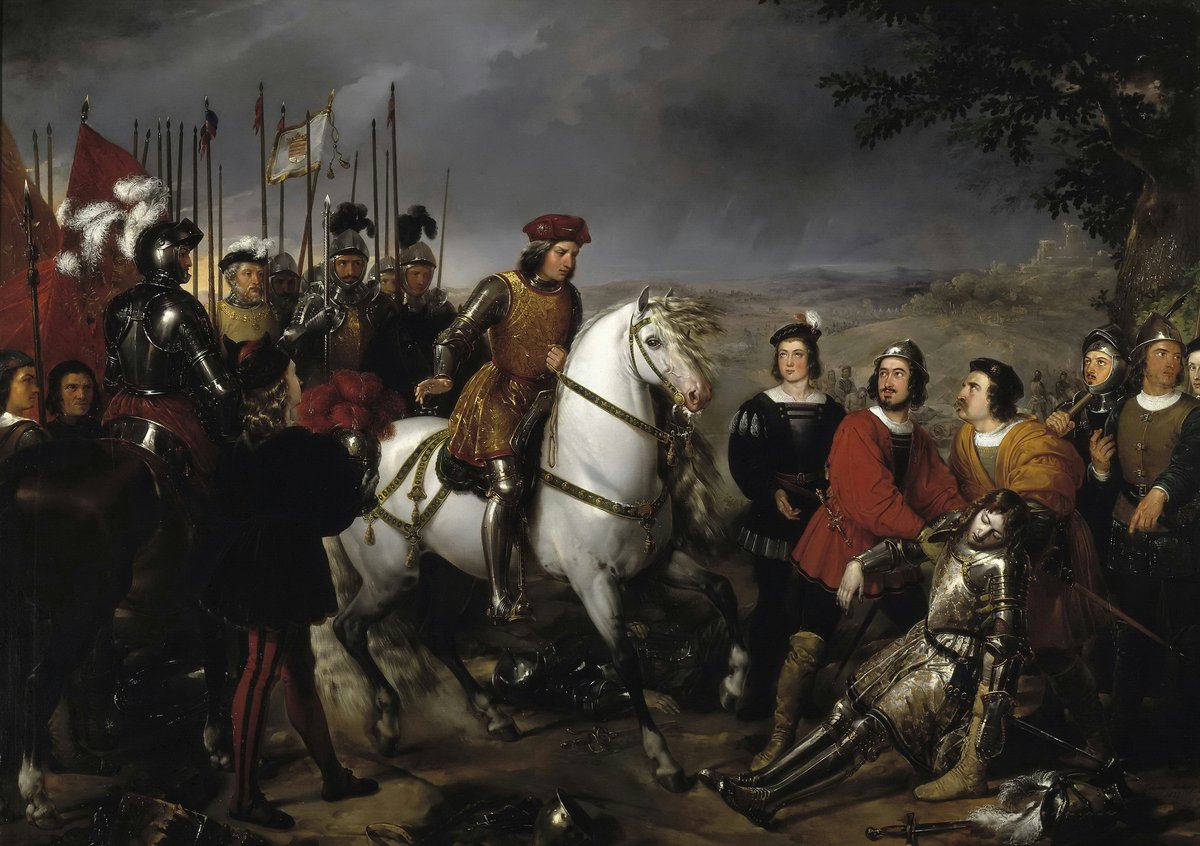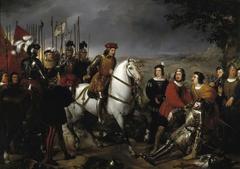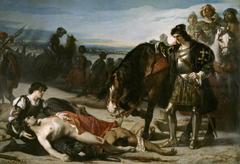
Battle of Cerignola Visiting Hours, Tickets, and Guide to Cerignola Historical Sites
Date: 14/06/2025
Introduction: The Battle of Cerignola and Its Historical Significance
Set in the scenic Apulia region of southern Italy, the Battle of Cerignola site stands as a testament to a pivotal moment in European military history: the first major battle decisively won through the use of firearms, on April 28, 1503. Here, Spanish troops under Gonzalo Fernández de Córdoba defeated the French army, shifting the course of the Italian Wars and marking the ascendancy of infantry armed with arquebuses over traditional heavy cavalry. Today, the battlefield and the town of Cerignola invite visitors to step into this transformative period of Renaissance warfare while enjoying the region’s cultural and culinary richness.
This guide compiles everything you need to plan your visit: from historical context and what to see, to up-to-date visiting hours, ticketing, accessibility, and local travel tips. Notable features include the preserved battlefield, monuments honoring military leaders, detailed interpretive panels, and the Museo Civico di Cerignola with its exhibits on the battle’s tactics, weaponry, and broader European impact.
Cerignola is readily accessible by train or car from Bari, Foggia, and Naples. In addition to the battlefield, the town boasts landmarks such as the Castello di Cerignola, the Cathedral of Santa Maria Assunta, bustling markets, and acclaimed Apulian cuisine. Annual commemorations, complete with reenactments and expert tours, further animate the town’s historical legacy.
For the latest updates, virtual tours, and additional resources, be sure to check the Cerignola Tourism, Italy Review, and Academia Lab websites.
Table of Contents
- Discover the Battle of Cerignola: History & Visitor Information
- Detailed Guide to the Battlefield
- Cerignola’s Key Historical & Cultural Sites
- Practical Information
- Visual & Media Suggestions
- Internal & External Links
- Summary & Conclusion
- References
Discover the Battle of Cerignola: History & Visitor Information
Historical Overview: The Battle That Changed Warfare
On April 28, 1503, the fields near Cerignola witnessed a clash that would reshape military history. Spanish forces, led by Gonzalo Fernández de Córdoba, implemented innovative defensive tactics and made strategic use of firearms—particularly the arquebus—against the French army. This victory marked the decline of heavy cavalry and began a new era in European warfare (Academia Lab).
Location & Getting There
The battlefield sits on a gentle rise just outside Cerignola, in the province of Foggia. The site is surrounded by open, agricultural terrain reminiscent of its 16th-century appearance. Cerignola is approximately 80 km from Bari and is accessible via:
- Car: Via the A14 and SS16 highways (ample parking in town; limited spaces near the site).
- Train: Cerignola Campagna station connects to Bari, Foggia, and Naples. Taxis and local buses provide onward access.
- Air: Bari Karol Wojtyła Airport is about 90 km away, offering car rentals and train links.
For detailed travel info, check Trenitalia and Puglia’s official tourism portal.
Visiting Hours & Tickets
- Battlefield: Open-access public area, 24/7 year-round, with no entrance fee.
- Cerignola Civic Museum: Open Tuesday–Sunday, 9:00–13:00 & 16:00–19:00 (subject to seasonal variation; verify at Museo Civico). Museum tickets may be required.
- Guided Tours: Available by reservation through the museum or tourism office; special tickets may apply for group or educational visits.
Main Monuments & Memorials
- Battlefield Memorial: A monument with bilingual inscriptions (Italian/Spanish) stands at the heart of the site, commemorating the Spanish victory.
- Interpretive Panels: Detailed bilingual maps and explanations outline troop movements and tactical innovations.
- Nearby Museum: The Museo Civico di Cerignola houses artifacts, period weapons, and dioramas related to the battle.
Guided Tours & Events
- Guided Tours: Led by local historians, tours trace the battle’s events and strategic points. Tours can be arranged in English, Italian, or Spanish.
- Annual Reenactments: Around April 21–28, the town hosts commemorations, including costumed reenactments, lectures, and cultural fairs.
- Special Exhibitions: Temporary displays and educational workshops often coincide with the battle’s anniversary.
Nearby Attractions & Travel Tips
- Historic Center: Wander Cerignola’s centro storico with its medieval streets, markets, and Renaissance-era churches.
- Castello di Cerignola: The town’s 15th-century fortress, open to the public, offers panoramic views and historical context.
- Religious Landmarks: The Cathedral of Santa Maria Assunta, Basilica di San Pietro Apostolo, and Chiesa dell’Immacolata are all accessible and free to enter.
- Local Cuisine: Sample olives (Oliva di Cerignola DOP), local wines, and traditional Apulian dishes at restaurants and markets.
- Accommodations: Options range from hotels and B&Bs to agriturismi; advance booking is advised during major events.
Visual & Interactive Media
- Virtual Tours: Available on the Cerignola tourism site.
- On-Site QR Codes: Interpretive panels include QR codes linking to digital maps, images, and historical summaries.
- Photography: The Ofanto River, battlefield monument, and panoramic town vistas provide excellent photo opportunities.
Detailed Guide to the Battlefield
Setting & Features
The battlefield is characterized by gently rolling fields that echo the original 16th-century landscape. While the defensive ditches and artificial slopes constructed by the Spanish are no longer fully visible, the site’s contours allow visitors to appreciate its strategic significance (Italy Review).
Accessibility & Facilities
- Parking: Available nearby, but limited during major commemorations.
- Restrooms: Not available at the battlefield; use facilities in the town center.
- Paths: Informal walking trails; terrain can be uneven—sturdy shoes recommended.
- Accessibility: Partially accessible for those with limited mobility; some paths unpaved.
Educational Value
- Interpretive Panels: Use maps, illustrations, and diagrams to help visitors visualize troop deployments and battlefield tactics.
- Guided Tours: Offer personalized experiences, often led by historians or educators, and can be tailored for different knowledge levels.
- Museum Exhibits: The Museo Civico di Cerignola provides in-depth displays on military technology and the broader context of the Italian Wars.
Cerignola’s Key Historical & Cultural Sites
Battlefield of Cerignola
- Access: Free, open year-round.
- Guided Tours: Available upon request; typically between 9:00–18:00.
- Photographic Spots: Panoramic river views, main monument, and reconstructed fortifications.
Castello di Cerignola
- Hours: Tuesday–Sunday, 10:00–17:00.
- Tickets: €5 adult admission; discounts for children/seniors.
- Features: Panoramic town views, exhibits on local history, weekend guided tours.
Centro Storico di Cerignola
- Access: Open at all times; shops/markets operate 9:00–20:00.
- Highlights: Renaissance churches, 19th-century palazzi, bustling squares.
- Walking Tours: Free seasonal tours bookable via the tourist office.
Religious & Architectural Landmarks
- Cathedral of Santa Maria Assunta: Daily 8:00–12:00, 16:00–19:00; free entry.
- Basilica di San Pietro Apostolo: 9:00–18:00; free entry, guided tours on request.
- Chiesa dell’Immacolata: 7:00–19:00; free entry.
Museums & Cultural Institutions
- Museo Civico Archeologico di Cerignola: Tuesday–Sunday, 9:00–13:00, 15:00–19:00; €4 admission.
- Palazzo Vescovile: Guided tours Wednesday–Sunday at 10:00 & 15:00; €6 entry.
Other Notable Sites
- Palazzo del Municipio: Admire the exterior and attend events in the adjacent square.
- Churches of Sant’Antonio Abate and San Francesco: Open 8:00–19:00; free.
- Parrocchia Santi Medici Cosma e Damiano: Open during weekend services.
Parks & Natural Attractions
- Parco Naturale Regionale dei Boschi di Cerignola: Year-round access, free entry, hiking trails, and picnic areas.
- Parco Commerciale di Cerignola: Outskirts of town; green space for relaxation.
Practical Information
Best Times to Visit
- Spring (April–June): Mild weather, commemorative events, wildflowers in bloom.
- Autumn (September–October): Pleasant temperatures, fewer crowds, grape/olive harvests.
Safety, Etiquette, & Travel Tips
- Respect the Site: Stay on marked paths, avoid disturbing memorials.
- Weather: Bring sun protection and water in summer; expect mild, occasionally rainy winters.
- Language: Italian is primary; English spoken at tourist sites and on guided tours.
- Emergency Services: Dial 112; the nearest hospital is Ospedale Tatarella di Cerignola.
Sustainable & Responsible Tourism
- Support Local Producers: Buy Cerignola olives, wines, and crafts.
- Eco-Friendly Travel: Use public transport or bicycles where possible.
- Engage with Community: Join tours and events to support local heritage efforts.
Frequently Asked Questions (FAQ)
Q: Are tickets required to visit the battlefield?
A: No, the battlefield is a free public area, open 24/7.
Q: What are the visiting hours for the Civic Museum?
A: Typically Tuesday–Sunday, 9:00–13:00 & 16:00–19:00. Confirm on the official website.
Q: Is the battlefield accessible for people with limited mobility?
A: Partially; some uneven ground may present challenges.
Q: Are guided tours available?
A: Yes, bookable through the museum or tourist office in multiple languages.
Q: When is the best time to visit?
A: Late April for commemorations, or spring/autumn for pleasant weather and fewer crowds.
Q: Where can I park?
A: Ample parking in Cerignola town; limited spaces at the battlefield.
Q: Are restrooms available?
A: Not on the battlefield; use facilities in the town center.
Visual & Media Suggestions
- Include images with descriptive alt text, e.g., “Battle of Cerignola visiting hours monument,” “View of Castello di Cerignola fortress,” or “Panoramic landscape of the Cerignola battlefield.”
- Use maps to highlight the battlefield, key monuments, and walking trails.
- Share virtual tours and videos from the Cerignola Tourism Office.
Internal Links
- [Top Historical Sites in Apulia]
- [Guide to Italian Renaissance Castles]
- [Best Food Experiences in Southern Italy]
External Links
- Official Cerignola Tourism Website
- Battle of Cerignola Virtual Tour
- Cerignola Civic Museum
- Italy Review: Cerignola
- Academia Lab: Battle of Cerignola
- Viaggiare in Puglia
Summary
A visit to the Battle of Cerignola site offers a remarkable journey into a key event in European military history. The battlefield’s preserved landscape, monuments, and interpretive materials vividly recount the events of April 1503. Cerignola’s broader heritage—its castles, cathedrals, museums, and vibrant local traditions—ensures a rich and immersive visitor experience.
Annual reenactments and educational tours, combined with modern virtual resources, make the site accessible and engaging for all. By planning ahead with official portals and embracing responsible tourism, visitors both enjoy and help preserve this significant landmark for future generations.
For further details, always consult the latest updates from Cerignola Official Tourism, Italy Review, and Academia Lab.
References and Further Reading
- Cerignola Tourism
- Italy Review: Cerignola
- Academia Lab: Battle of Cerignola
- Cerignola Civic Museum
- Viaggiare in Puglia

